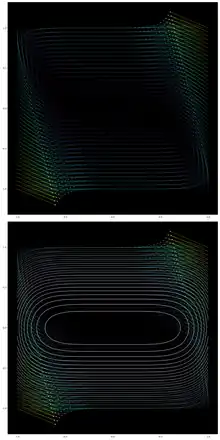LaSalle's invariance principle
LaSalle's invariance principle (also known as the invariance principle,[1] Barbashin-Krasovskii-LaSalle principle,[2] or Krasovskii-LaSalle principle) is a criterion for the asymptotic stability of an autonomous (possibly nonlinear) dynamical system.
Global version
Suppose a system is represented as
where is the vector of variables, with
If a (see Smoothness) function can be found such that
- for all (negative semidefinite),
then the set of accumulation points of any trajectory is contained in where is the union of complete trajectories contained entirely in the set .
If we additionally have that the function is positive definite, i.e.
- , for all
and if contains no trajectory of the system except the trivial trajectory for , then the origin is asymptotically stable.
Furthermore, if is radially unbounded, i.e.
- , as
then the origin is globally asymptotically stable.
Local version
If
- , when
hold only for in some neighborhood of the origin, and the set
does not contain any trajectories of the system besides the trajectory , then the local version of the invariance principle states that the origin is locally asymptotically stable.
Relation to Lyapunov theory
If is negative definite, then the global asymptotic stability of the origin is a consequence of Lyapunov's second theorem. The invariance principle gives a criterion for asymptotic stability in the case when is only negative semidefinite.
Examples

Simple example
Example taken from.[3]
Consider the vector field in the plane. The function satisfies , and is radially unbounded, showing that the origin is globally asymptotically stable.
Pendulum with friction
This section will apply the invariance principle to establish the local asymptotic stability of a simple system, the pendulum with friction. This system can be modeled with the differential equation[4]
where is the angle the pendulum makes with the vertical normal, is the mass of the pendulum, is the length of the pendulum, is the friction coefficient, and g is acceleration due to gravity.
This, in turn, can be written as the system of equations
Using the invariance principle, it can be shown that all trajectories that begin in a ball of certain size around the origin asymptotically converge to the origin. We define as
This is simply the scaled energy of the system.[4] Clearly, is positive definite in an open ball of radius around the origin. Computing the derivative,
Observe that . If it were true that , we could conclude that every trajectory approaches the origin by Lyapunov's second theorem. Unfortunately, and is only negative semidefinite since can be non-zero when . However, the set
which is simply the set
does not contain any trajectory of the system, except the trivial trajectory x = 0. Indeed, if at some time , , then because must be less than away from the origin, and . As a result, the trajectory will not stay in the set .
All the conditions of the local version of the invariance principle are satisfied, and we can conclude that every trajectory that begins in some neighborhood of the origin will converge to the origin as .[5]
History
The general result was independently discovered by J.P. LaSalle (then at RIAS) and N.N. Krasovskii, who published in 1960 and 1959 respectively. While LaSalle was the first author in the West to publish the general theorem in 1960, a special case of the theorem was communicated in 1952 by Barbashin and Krasovskii, followed by a publication of the general result in 1959 by Krasovskii.[6]
See also
Original papers
- LaSalle, J.P. Some extensions of Liapunov's second method, IRE Transactions on Circuit Theory, CT-7, pp. 520–527, 1960. (PDF Archived 2019-04-30 at the Wayback Machine)
- Barbashin, E. A.; Nikolai N. Krasovskii (1952). Об устойчивости движения в целом [On the stability of motion as a whole]. Doklady Akademii Nauk SSSR (in Russian). 86: 453–456.
- Krasovskii, N. N. Problems of the Theory of Stability of Motion, (Russian), 1959. English translation: Stanford University Press, Stanford, CA, 1963.
Text books
- LaSalle, J.P.; Lefschetz, S. (1961). Stability by Liapunov's direct method. Academic Press.
- Haddad, W.M.; Chellaboina, VS (2008). Nonlinear Dynamical Systems and Control, a Lyapunov-based approach. Princeton University Press. ISBN 9780691133294.
- Teschl, G. (2012). Ordinary Differential Equations and Dynamical Systems. Providence: American Mathematical Society. ISBN 978-0-8218-8328-0.
- Wiggins, S. (2003). Introduction to Applied Nonlinear Dynamical Systems and Chaos (2 ed.). New York City: Springer Verlag. ISBN 0-387-00177-8.
Lectures
- Texas A&M University notes on the invariance principle (PDF)
- NC State University notes on LaSalle's invariance principle (PDF).
- Caltech notes on LaSalle's invariance principle (PDF).
- MIT OpenCourseware notes on Lyapunov stability analysis and the invariance principle (PDF).
- Purdue University notes on stability theory and LaSalle's invariance principle (PDF).
References
- Khalil, Hasan (2002). Nonlinear Systems (3rd ed.). Upper Saddle River NJ: Prentice Hall.
- Wassim, Haddad; Chellaboina, VijaySekhar (2008). Nonlinear Dynamical Systems and Control, a Lyapunov-based approach. Princeton University Press.
- Grant, Christopher (1999-10-22). "LaSalle's Invariance Principle, Lecture 23, Math 634" (PDF). Archived from the original (PDF) on 2019-07-14. Retrieved 2022-06-28.
- Lecture notes on nonlinear control, University of Notre Dame, Instructor: Michael Lemmon, lecture 4.
- Lecture notes on nonlinear analysis, National Taiwan University, Instructor: Feng-Li Lian, lecture 4-2.
- Vidyasagar, M. Nonlinear Systems Analysis, SIAM Classics in Applied Mathematics, SIAM Press, 2002.